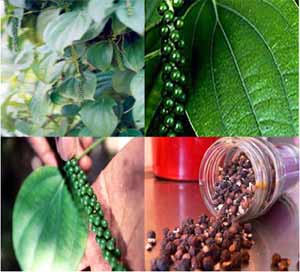
Introduction: Black pepper is the dried, mature but unripe berry (fruit) of Piper nigrum, a branching vine or climbing, perennial shrub. Black pepper is the most important spice of India and world due to its day-to-day use.
It is therefore rightly considered as the ‘king of spices’. It comes from the berries of the pepper plant.
The Black pepper, green pepper and white peppercorns are actually the same fruit (Piper nigrum); the difference lies in their colour which reflects the varying stages of development and processing methods.
Black peppercorns are made by picking the pepper berries when they are half ripe and just about to turn red.
They are then left to dry which causes them to shrivel and become dark in color. Alternatively, green peppercorns are picked while still unripe and green in color, while white peppercorns are picked when very ripe and subsequently soaked in brine to remove their dark outer shell leaving just the white pepper seed.
Black pepper is the most pungent and flavorful of all types of peppers and it is available as whole or cracked peppercorns or ground into powder.
Indian Names of Pepper: It is being recognized by different names in various parts of the country. In Hindi as Kalimirch, in Sanskrit as Maricha ushana and hopusha, in Punjabi as Kalimirch, in Marathi as Ale, in Bengali as Kala Mirch and Golmarich, in Telugu as Miriyalu, in Tamil as Milagu, in Gujarati as Kalamari and Kalomirch, in Kannada as Kare menasu, in Kashmiri as Marutis, in Malayalam as Kurumulaku and Nallamulaku, in Orriya as Gol-maricha and in Urdu as Kalimirch, Siah mirch.
Varieties: Depending upon the localities where they grown or from ports through which they are being exported, it has different names e.g. Malabar, Alleppey (Kerala), Lampang, Saigon and Singapore.
Majority of the cultivated varieties are monoecious i.e. male and female flowers found in the same spike.
Peppers differ slightly in their physical and chemical characteristics; colour, size, shape, flavour and bite.
Black pepper is more aromatic than the other varieties of pepper. It is native to Malabar and has been grown here for more than 2000 years. The best Black Pepper is considered to be Telicherry and Lampong.
The most popular varieties from India are Malabar Garbled and Tellichery Black. Tellichery and Alleppey peppers are large, attractive, dark reddish-brown to black, very aromatic and are among the best.
Same in case of the Malabar Garbled (MGI), which alone accounts for nearly 90% of the total exports from India.
[indeed-social-locker sm_list=’fb,tw,go1′ sm_template=’ism_template_1′ sm_list_align=’horizontal’ sm_display_counts=’false’ sm_display_full_name=’true’ locker_template=2 sm_d_text='<h2>This premium content is locked</h2><p>Share This Page To Unlock The Content!</p>’ ism_overlock=’default’ ]
Properties and Uses: Black pepper contains essential oil (up to 3.5%) and 5 – 10% pungent acid-amides with piperine as well as piperyline, piperoleines and piperamine, while the oil contains sabinene, pinene, phellandrene, linalool and limonene. It is analgesic, antiseptic, anti-spasmodic, cardiac, carminative, digestive, diuretic, laxative, stimulant and tonic.
Piperine is known as a central nervous system depressant and has good anticonvulsant and antimicrobial properties. It stimulates both the digestive and circulatory system and, apart from this, has insecticidal properties, Therapeutic uses, Internal use, used in the West to aid digestion, relieve gas and in Chinese medicine to treat food poisoning, stomach chills, cholera, dysentery, vomiting caused by hypothermia.
It is also used in Ayurvedic medicine to stimulate the digestive system and is used for treatment of nausea, lack of appetite and other dyspeptic complaints.
A common myth in the West is that pepper cannot be digested and remains in the digestive tract for 7 to 8 years. This is just a myth and contrary to the working of the digestive system, as the digestive tract has no way of treating pepper differently from any other food substance consumed.
Pepper is absorbed and eliminated by the body in exactly the same way as any other food. Pepper, white or black, is very common and is used to flavor most savory dishes, meats, chicken, fish, dressing sauces, pickles and cheese.
White pepper consists of the dried ripe berries and black pepper the dried unripe berries, white pepper being less aromatic. Unripe, fresh green berries are also used in sauces and to flavor various savory dishes.
Ayurvedic medicine uses pepper mixed with ghee (buttery type of compound) to treat nasal congestion sinusitis skin eruptions epilepsy Aromatherapy and essential oil use Black pepper essential oil is used for pain relief, increasing circulation, muscular aches, exhaustion and fevers.
It can also be used to treat toothache, rheumatic pains and for ecto-parasites. Since, it helps to increase circulation, it can be successfully used in any problem where poor circulation plays a part, and for this reason, it is included in a variety of products.
Safety precautions and warnings: Excessive topical use of the essential oil may over stimulate the kidneys. It should be avoided during pregnancy and it may also cause redness to the skin.
Contributed by:
Dr. Munish Sharma and Dr. Bharat Bhushan
Krishi Vigyan Kendra, Doda
S.K. University of Agricultural Sciences and Technology, Jammu (J&K)
[/indeed-social-locker]




